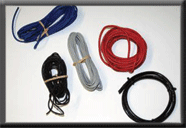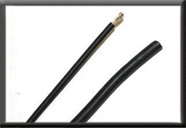 |
 |
 |
||||
There’s more too: The type of aluminum suited to the manufacture of wire must be soft. Soft aluminum tends to work-harden when stressed beyond its elastic limit. Eventually, it will become brittle and crack. Here’s how it happens: If a terminal is crimped to the end of a section of aluminum wire, the procedure disturbs the aluminum core. This disruption of the core initiates the work-hardening. And if the wire isn’t supported adequately (by way of cushioned clamps and/or cable ties), it is regularly subject to vibration. The work-hardening process continues. Bottom line: The wire will eventually fail. As a result, using aluminum core wire just isn’t worth it. Common Copper Practicality pretty much determines that copper is the wire of choice, but be forewarned: There are plenty of different types of copper wire. A good example is household wiring. A house wired with copper (which is common) will use thick, solid wire. On the flip side, the highly flexible cord for your toaster or coffee maker has a core consisting of finely stranded wire. There are big differences though: While your toaster cord is easy to bend, the wire inside the walls of your house is difficult to bend (more on this below). Copper is a very ductile material. What this means is you can wrap a piece of solid 10-gauge wire around a very tight bend without it losing much of its structural integrity. And if you straighten the wire and then re-bend it several times, it will eventually work-harden. If constantly bent and straightened, the ductility eventually diminishes. Fissures will begin to appear on the surface of the wire. If the bending process continues, the fissures will increase in size and the wire will fail. Multi-Strand Copper Wire There’s a better solution: Swap the solid wire for stranded copper wire. Imagine you place 19 strands of 22-gauge wire into a bundle. The bundle of little wires has approximately the same cross sectional area as the piece of solid wire. If this piece of stranded wire is bent over a tight radius (as discussed earlier), it won't have a tendency to fracture, because the reduction in size of the individual wire within the strand produces a roughly comparative reduction in stress. This means that stranded wire for automotive use is ideal. With stranded wire, you usually have a choice between something like 7-strand or 19-strand (using a small 22-gauge wire as the example). In the case of small size wire, such as 22-gauge, a total of seven strands of 30-gauge wire are used to make up the core. If 10 strands are incorporated into the mix then the strands are 43-gauge. Is one better than the other? When it comes to quality more strands inside the wire usually equates to better. There are some other considerations too: Copper is an "active" metal. Copper readily reacts with oxygen in the air along with moisture and of course, airborne contaminants. That’s why unprotected copper items usually turn a murky green in a month or two. When it comes to copper wire, there is no practical way to completely seal the circulation of air and moisture between the individual strands in the bundle. The reality is, the majority of plastic wire insulators are not barriers to the environment, particularly when exposed to gasoline, oil and other hydrocarbons Silver-, Tin, and Teflon-Plated Multi-Strand Since most automotive wire is not protected from the environment or from contamination, it usually has a service life of about 10 years. After that, the deterioration process begins. Can this wear-and-tear be thwarted? Yes, but the wire must be plated prior to the stranding process. That’s where the silver-plated copper wire comes in, but more common plating is by way of tin. It is relatively easy to process and once applied, makes the copper wire much more resistant to chemicals and good old-fashioned air and moisture contamination than non-plated copper. FYI, wire that’s sold for aviation applications is usually tin-plated.As automotive and aviation wire evolved, the covering material went from shellacked cotton braid to plastic to PVC plastic to compounds fortified with synthetic braids. PVC-covered wire is pretty common today, but plastic isn’t perfect. In fact, it’s porous. Contaminants eventually pass through a PVC jacket and attack the wire (particularly unplated copper wire). Another solution is a wire jacket manufactured from Teflon. From a wire covering perspective, Teflon is miraculous stuff. It remains flexible and soft at both ends of its operating temperature. Unfortunately, Teflon isn’t perfect either. The material isn’t very resistant to abrasion. Within the aircraft industry, the solution was to wrap the Teflon coated wire with a PVC jacket. That’s a major cost factor since the wire must first be plated in silver or nickel, before the Teflon can be formed over the bundle. Then there’s one more issue with Teflon-wrapped wire: In a fire, Teflon can give off fumes that are toxic to breathers. PVC-Insulated Wire That definitely narrows the choices for wire you can use to wire those driving lamps or the winch in your vehicle. PVC insulated wire can be used in most locations, with the possible exception of a spot very close to the engine. There are two temperature ranges found in most PVC insulation that is readily available: One is rated at 221 degrees Fahrenheit, while the other is rated at 176 degrees Fahrenheit. A Teflon jacket is different. It won’t melt at temperatures in the 400-500-degree Fahrenheit range. What sort of temperatures do cars reach? Wiring outside of the engine compartment can often encounter temperatures as high as 180 degrees, but engine compartment temperatures can go as high as 300 degrees or more in specific locations. Mix in the chemicals used in automobiles, and you can see we’re asking a lot from wire jackets. You might hear the word “Tefzel” when it comes to wire jackets or sleeves. This stuff is related to Teflon, but it isn’t quite as resistant to high temperatures. It’s more abrasion-resistant though. For certain applications, it might be perfect, but you won’t be able to find it at the local auto parts store. It can be located at aircraft avionics shops and at some aircraft surplus outlets. For the most part, Tefzel is manufactured in a good range of gauge sizes but it’s not cheap. If high temperature and abrasion protection are critical, you’ll find there are some different wire sleeves that can be added to the wire harness. Several aftermarket ignition component manufacturers offer varied products for the purpose. When all is said and done, there really is one path to follow when picking wire for your automotive electrical jobs. Use fine, multi-strand copper wire. The more strands in the core, the better. If you can afford it, use a silver-plated or nickel-plated wire, and if you can’t swing the cost, use a tin-plated copper wire. If the wire has a PVC jacket, keep an eye out for excessive heat. If you select Teflon-jacketed wire, watch for potential abrasion. Consider using an extra wire over-wrap, and don’t forget to support an added harness (don’t let it dangle in the breeze). In the end, better quality wire will definitely last longer and cause far fewer maintenance headaches. We can all relate to that. Get help with your car nowAsk a professional
As you’ve gathered from the article, the wire you choose when installing electrical bits in your vehicle is important. Wire is important, especially its construction. Wire is available in a range of gauges (diameters) and colors. When you dissect a section of high-quality wire you can see just how many strands are manufactured within the bundle. The wire with more strands inside the bundle is much more desirable than those with fewer strands. Plated wire is even more desirable, as it’s more resistant to contamination. When you increase the length of wire, it's a good idea to increase the size (diameter or “gauge”) of the wire. When wiring a specific component, you can’t go wrong with wire that’s too big, but keep in mind that large-diameter wire is hard to route, hard to bend, and often more difficult to crimp. Wire that’s too small, though, isn’t capable of carrying a specific load. Here, bigger is usually better. When routing numerous wires to a given location, it’s a good idea to provide support and protection for the wires. One of the best products for this purpose is aviation spiral wrap. Note how the custom harness is supported by equally-spaced cushion clamps. The idea here is to both protect the wire and to cushion it from vibration. I hope this article has helped you in you decide which automotive wire you will go with, There are many options when it comes to automotive wire, and I hope we have cleared up some questions for you. If you have more questions please post on our forums. |
||||||